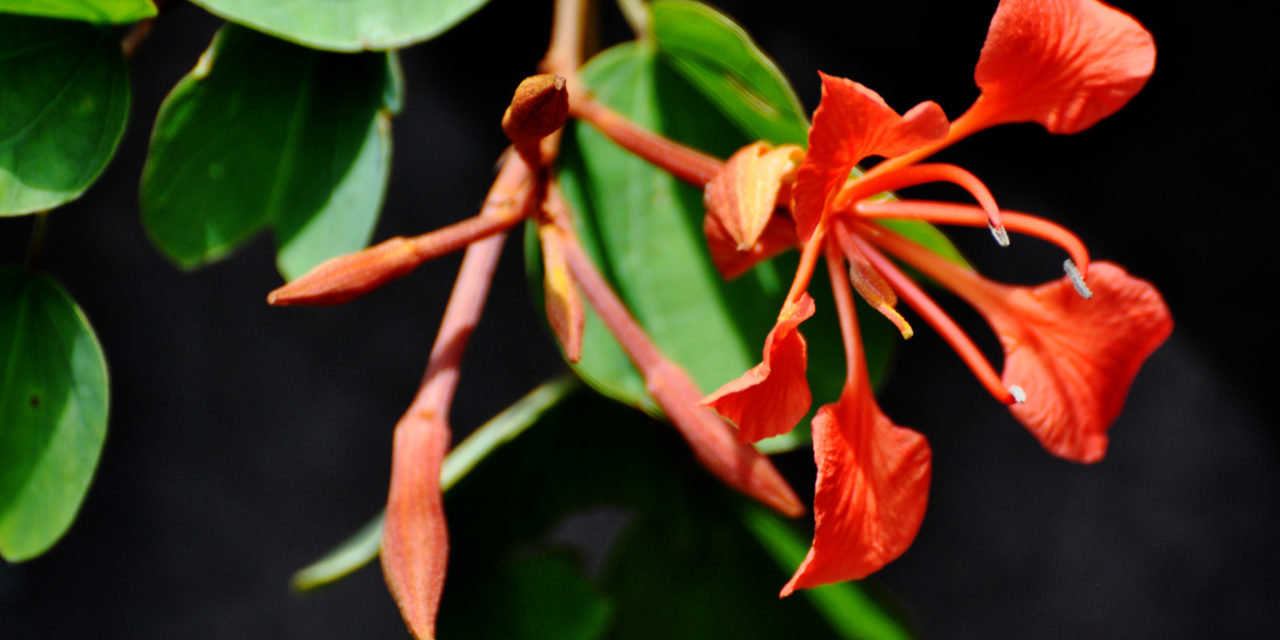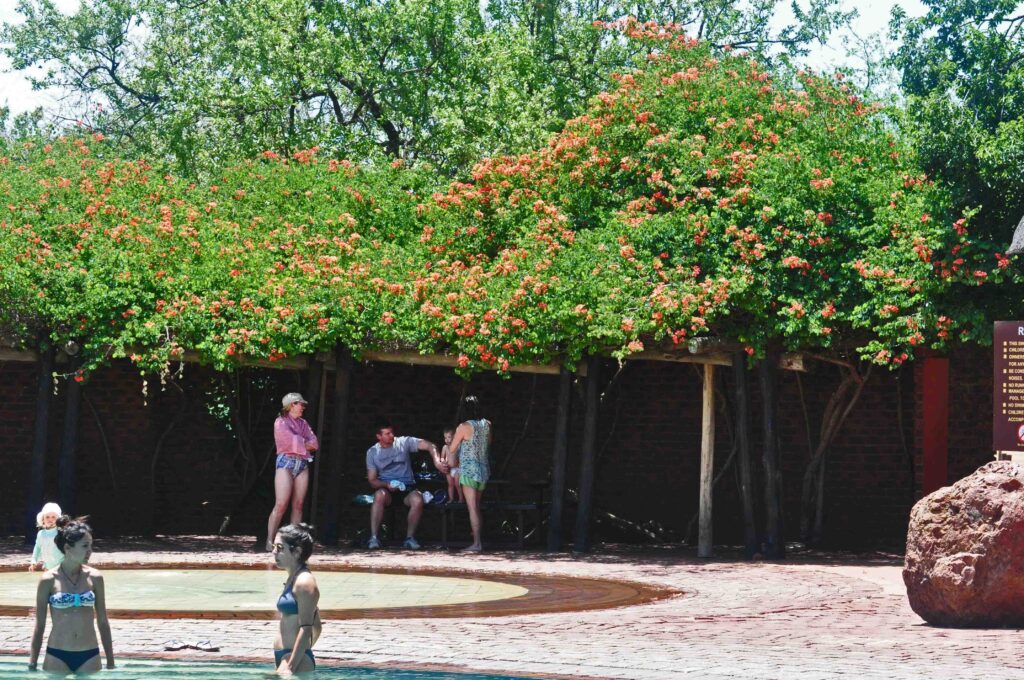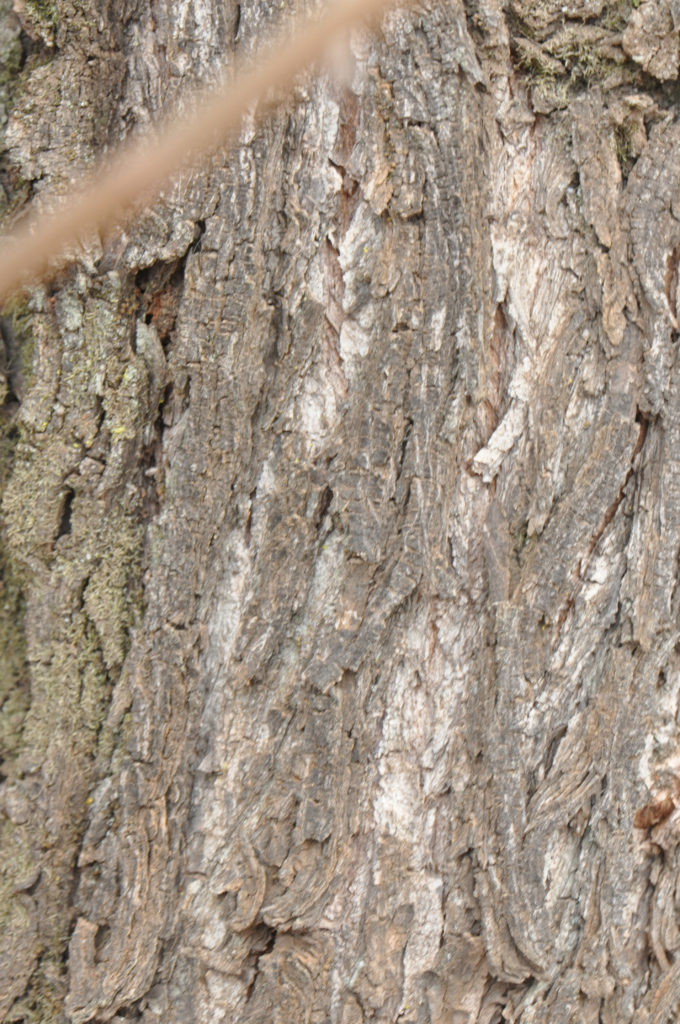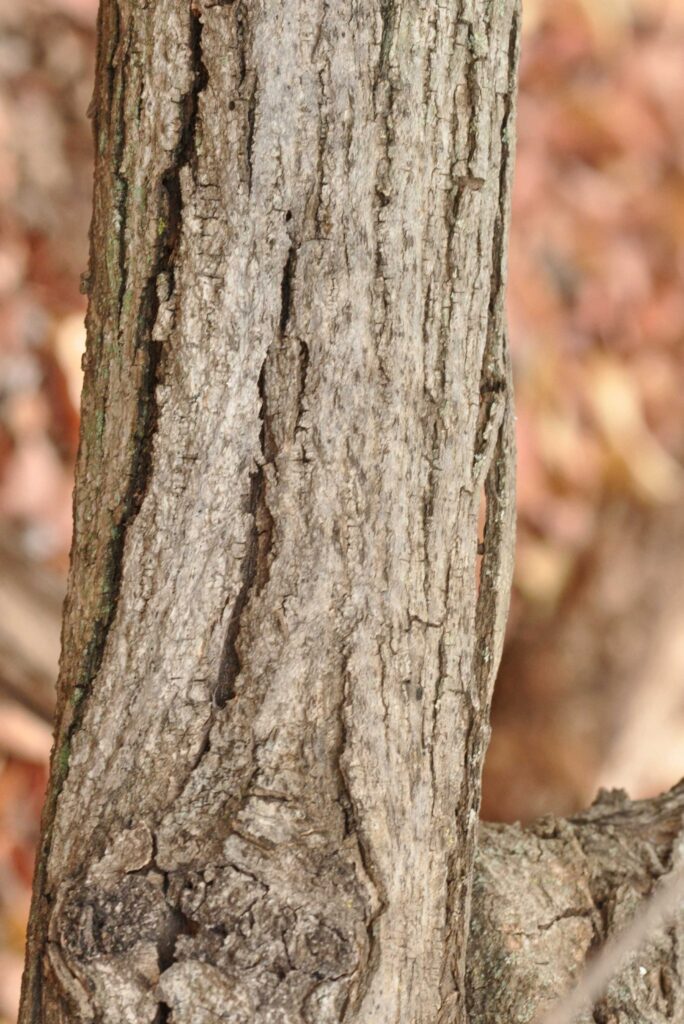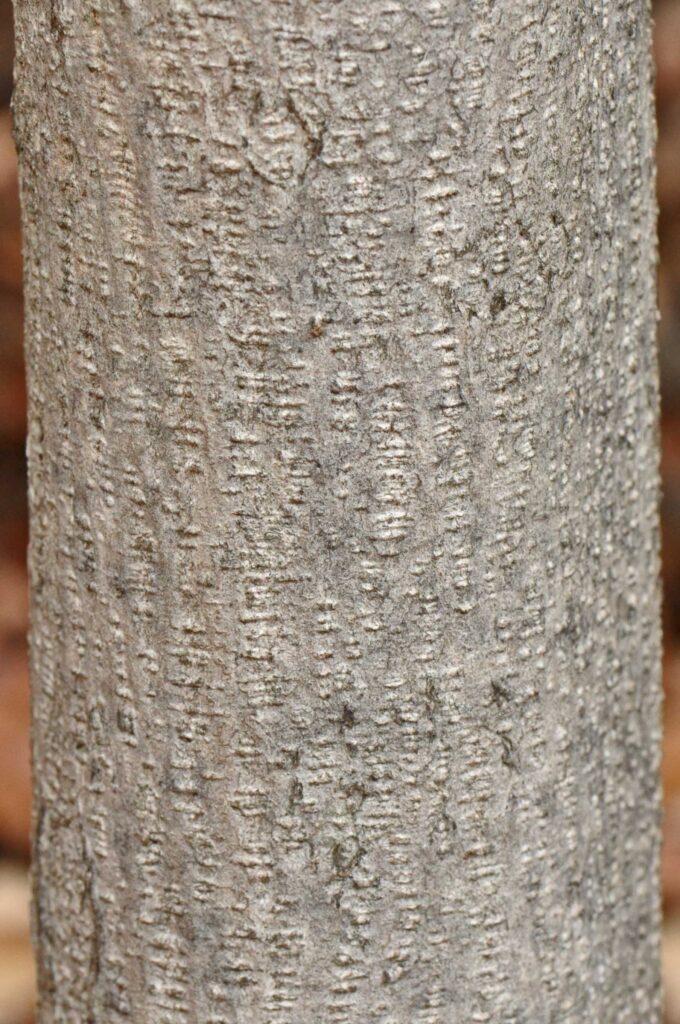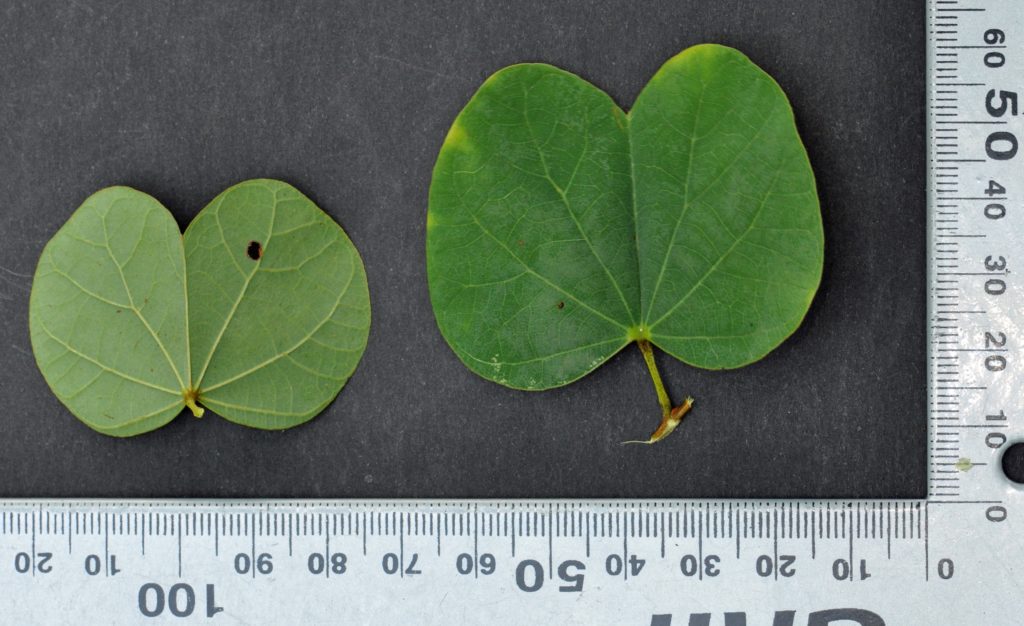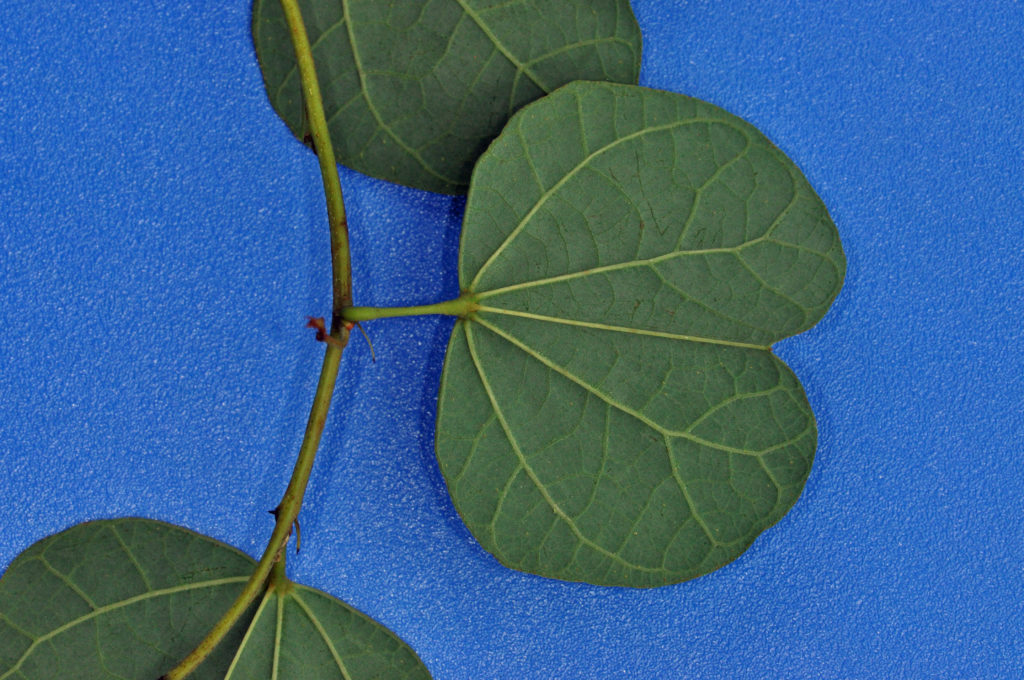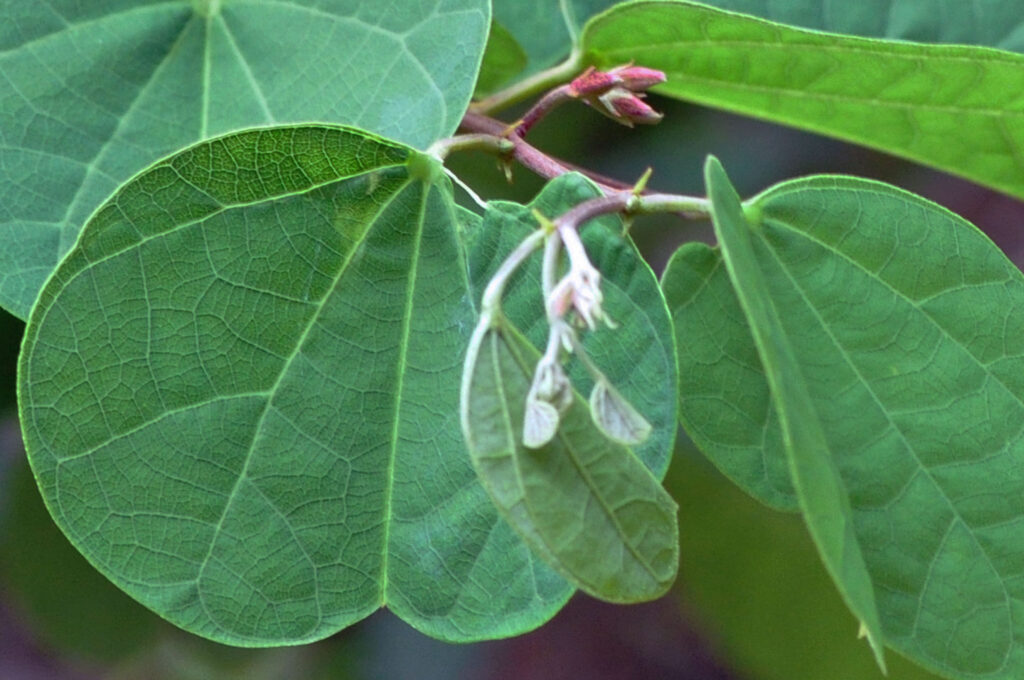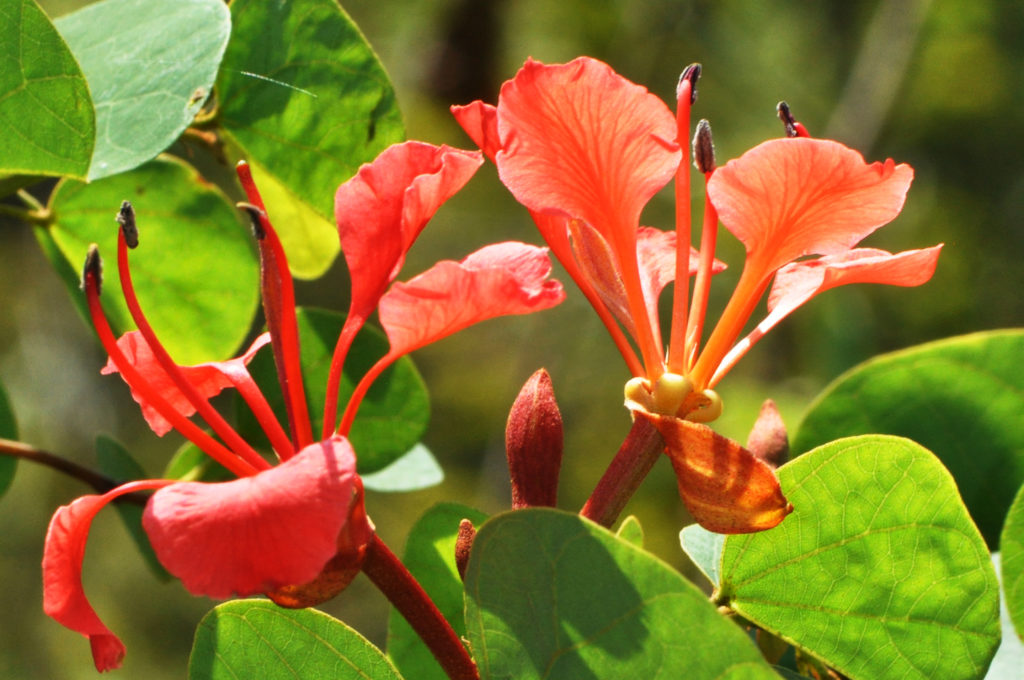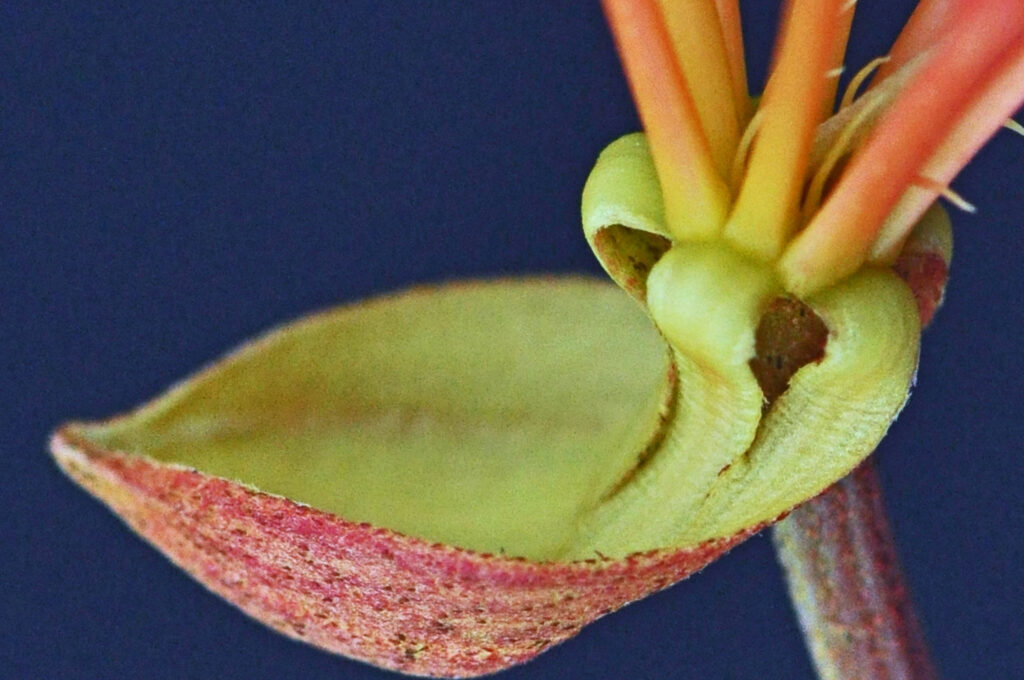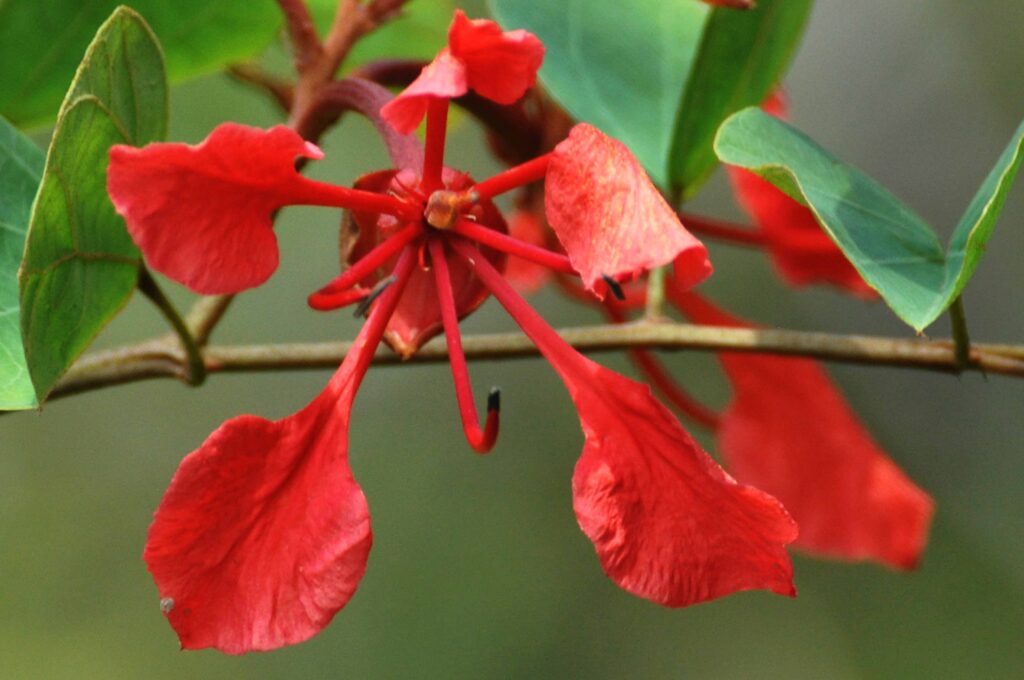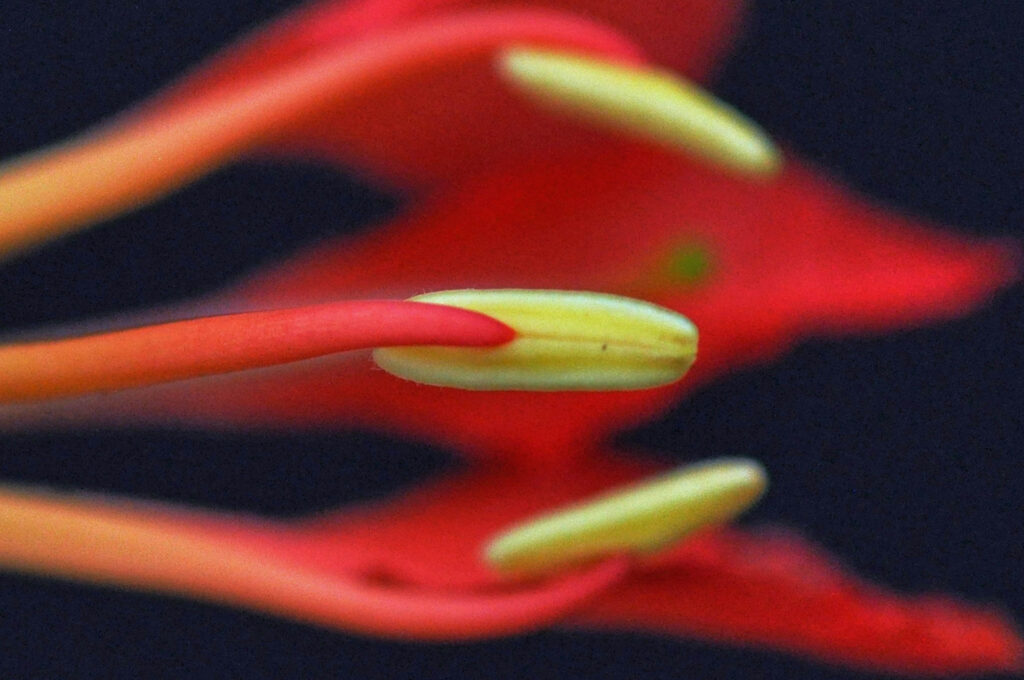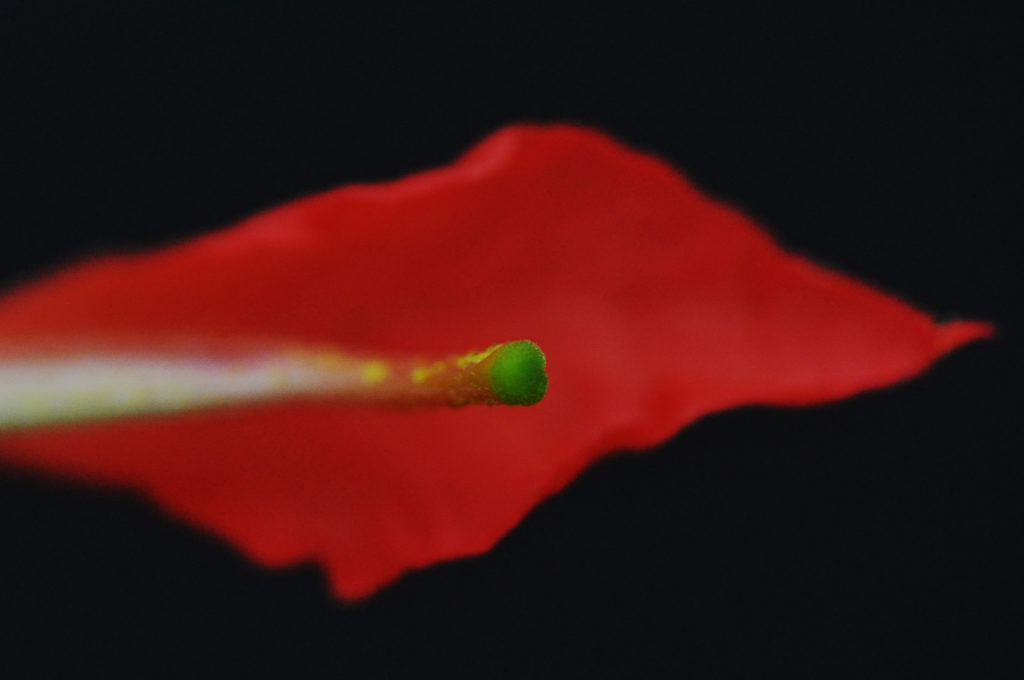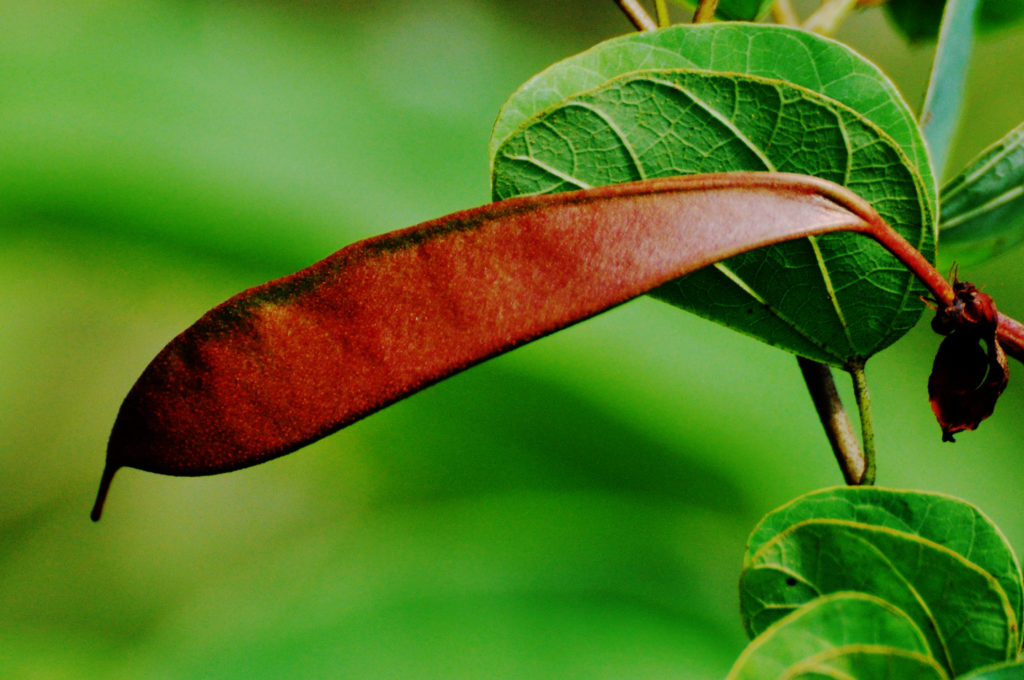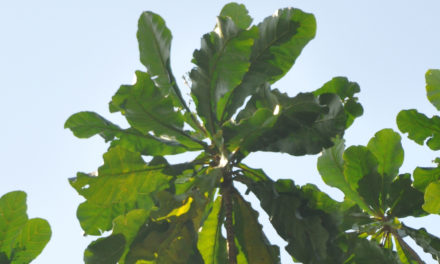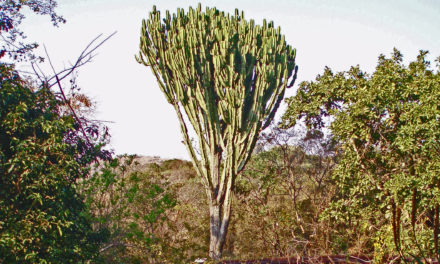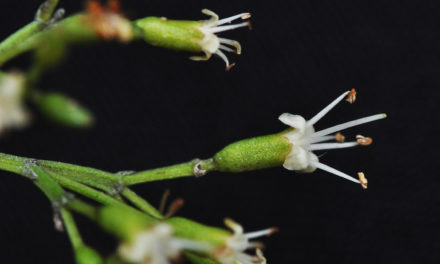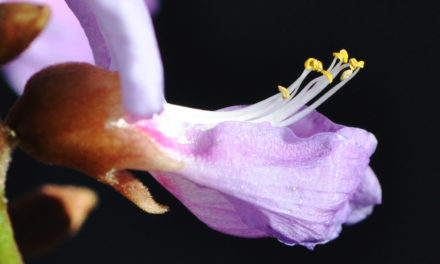General Info – summary
Multi-stemmed shrub, climber or Tree to 3+ m high. A simple, not deeply divided bilobed Leaf with base arising veins. Bisexual, slightly irregular, 5-merous, spectacular red Flowers in racemes. Joined green sepals with a spathe. Red obovate petals surround 3 stamens and 7 staminodes. Single pistil has a superior ovary + exerted style. Fruit: a narrow dehiscent red pod with thickened margins + compressed oval seeds.
Description
Bauhinia galpinii
Previous Names: Bauhinia punctate, Perlebia galpinii.
SA Tree No. 208.2
Common names: (Afr) Beesklouklimop, Beesklou-klimop, Vlam-van-die-vlakte, Vlam-van-de Kaap. (Eng) Lowveld Bauhinia, Pride Of De Kaap, Pride of De Kaap Bauhinia, Pride-of-de Kaap, Red Bauhinia. (isiZulu) Umdlandlovu, Umvangatane, Usololo. (Northern Sotho) Motshiwiriri. (siSwati) Isololo, Kisololo. (Tshivenda) Mutswiriri. (Xitsonga) Tswiriri. N.B. De Kaap refers to the valley best seen from Kaapsehoop (close to 1 500m) above sea level. The view from here is special. Kaapsehoop lies about 30km south-west of Mbombela (Nelspruit) in Mpumalanga – not from the Cape.
Common names: (Afr) Beesklouklimop, Beesklou-klimop, Vlam-van-die-vlakte, Vlam-van-de Kaap, Vlam-van-die-Vlakte. (Eng) Lowveld Bauhinia, Pride of De Kaap, Pride-of-de- Kaap, Red Bauhinia. (isiZulu) Umdlandlovu, Umvangatane, Usololo. (Northern Sotho) Motshiwiriri. (siSwati) Kisololo, Lisololo. (Tshivenda) Mutswiriri. (Xitsonga) Tswiriri. N.B. De Kaap refers to the valley best seen from Kaapsehoop (close to 1 500m above sea level). The view from here is special. Kaapsehoop lies about 30km south-west of Mbombela (Nelspruit) in Mpumalanga – not in the Cape.
Family: Fabaceae, or Leguminosae (Pea, bean or legume family). After the Orchidaceae and the Asteraceae, the Fabaceae is the third largest Angiosperm (flowering plants) family with 700+ genera and close to 20 000 species. Local Tree genera on this website include Acacia (Vauchellia, Senegalia), Albizia, Bauhinia, Bolusanthus, Burkea, Calpurnia, Colophospermum, Cordyla, Cyclopia, Dichrostachys, Erythrina, Erythrophleum, Faidherbia, Indigofera, Mundulea, Peltophorum, Philenoptera, Piliostigma, Schotia and Xanthocercis. The Fabaceae are recognisable by their fruit and their pinnately compound Leaves. Leaves may also be simple – even bilobed and usually have stipules – some of which may be spinescent. Leaflets are usually entire. Flowers are bisexual and bracteate. Regular flowers usually have 4-5 sepals and the same number of petals. Irregular flowers have 4-5 sepals and 5 or less petals. Stamens have anthers that have 2 pollen sacs and there are usually at least twice the number of stamens as petals – often 10. The superior Ovary has 1 locule containing 1 or more ovules. The Stigma and Style are simple. The single carpel develops into the Fruit, which is usually a pod. The mature pods may dehisce or break into segments.
Name derivation: Bauhinia – named after two brothers, Caspar and Jean Bauhin – Swiss botanists in the 16th century. Casper sorted out the massive confusion of plant description at the time and produced factual accounts of flowers, stems, leaves, and roots that would aid classification in years to come. The twin lobed leaves aid the identification of genus Bauhinia. galpinii named after Dr E.E. Galpin (1858-1941). He was a South African bank manager and noted Botanist. He travelled extensively in South Africa and Zimbabwe and collected about 16 000 plant specimens. There are several species of the genus Bauhinia in southern Africa.
Conservation: National Status: L C. Least Concern. Assessment: Raimondo et al. (2009).
Tree
This plant is usually a multi-stemmed shrub or climber (photo 445) and occasionally a low spreading Tree 3-8m high. The powdery Bark is a greyish brown (photo 972). Tendrils are absent. Lenticels (usually raised corky oval or elongated area on the plant that allows the uncontrolled interchange of gases with the environment are visible – photo 969). The initially hairy Branches are long and whip-like (photo 665 under Leaves).
- 445. 2018/11/21. Manyane – Pilanesberg. Photo: David Becking.
- 971 2016/10/18 Pretoria NBG. Photo: David Becking.
- 972 2016/10/18 Pretoria NBG. Photo: David Becking
- 969 2016/10/18 Pretoria NBG. Photo: David Becking.
Leaves
This evergreen plant has alternate bilobed (2-lobed) Leaves that are Simple (have a single blade, which may have incisions that are not deep enough to divide the leaf into leaflets). The notched Apex (photo 337) descends to about a fifth of the leaf length from the apex – not as deep as in Bauhinia bowkeri. Each notched leaf apex has a round end. The Base has 2 lobs with rounded tips (photo 337) and the Margin is without waves and is entire (with a continuous margin, not in any way indented). These large leaves are up to 7 x 7cm (photo 337). Veins are distinctly visible on the lighter green, lower side (photo 665). On this side, there are as many as 7 conspicuous, protruding veins that arise from the leaf base. They may branch prior to reaching the margin (photo 665). The veins appear slightly sunken on the upper side (Photo 119). The leaf folds along the central vein (photo 337). The Petiole (leaf stalk) is up to 1,5cm long. The slender Stipules (basal appendages of the petiole) are caducous (an organ or part, which is easily detached and shed early – photos 665 & 119).
- 337 2015/02/24 Walter Sisulu NBG. Photo: David Becking.
- 665 2017/01/31 Pretoria NBG. Photo: David Becking.
- 119 2017/12/26 Pretoria NBG. Photo: David Becking.
Flowers
Throughout the summer, these Flowers usually occur in large numbers and are clustered near the ends of branches. The very impressive, bisexual flowers are in Racemes (a simple elongated inflorescence with stalked flowers that open in succession towards the apex). Each flower is about 8cm wide and is zygomorphic (irregular flower with the corolla divisible into 2 equal halves in one plane only). The characteristic pink to brick red flower colour (the only red Bauhinia in the region) extends to all parts, including the Pedicel (stalk of a single flower – photo 339). The 5-lobed Calyx is gamosepalous (a calyx whose sepals are at least partly united). It has an attached Spathe (one or more bracts enclosing a flower or inflorescence) that is split to the base on one side only (photos 339 & 250). Here the outer surface is reddish, and the inner surface is initially green. The Corolla has 5 paddle-shaped Petals (each about 5cm wide) which are distinctly obovate (like an upside-down egg with a long narrower end at the base – photo 342). These 5 unusual petals end in a wide lobe that is round and wavy. Three distinctive Stamens that alternate with the petals are visible (photo 342) and the remaining 7 are reduced to Staminodes (sterile stamens – some visible in photo 250). The Filaments are an even darker red than the petals and bend inwards towards the flower centre (Photo 339). The Anthers have parallel theca (pollen sacs) and are initially bright yellow (photo 251). Here the filaments are attached to the centre of the anthers. They age to a much darker colour (photo 339). There is a single Pistil (a unit of the Gynoecium, the female element of the flower, composed of the Ovary, Style and Stigma). The superior, stalked Ovary has a single locule. There is a single exserted (sticking out; projecting beyond) Style with a single, initially green Stigma (photo 253). (Sep-May+).
- 339 2015/02/24 Walter Sisulu NBG. Photo: David Becking.
- 250 2018/01/11 Walter Sisulu NBG. Photo: David Becking.
- 342 2015/02/24 Walter Sisulu NBG. Photo: David Becking.
- 251 2018/01/11 Walter Sisulu NBG. Photo: David Becking.
- 253 2018/01/11 Walter Sisulu NBG. Photo: David Becking.
Fruit
The narrow, dehiscent, red to brown Fruit (photo 342) is an initially slightly hairy Pod that develops up to 14 x 3cm in size. It has distinct ridges along both edges and ends in a thin extended tip that is the remains of the Style (photo 342). Each hard, woody, mature, pod contains compressed oval Seeds. (Mar-Aug).
- 342 2015/02./24 Walter Sisulu NBG. Photo: David Becking.
Distribution & Ecology
The usual location of this Plant is in rocky areas close to water – even up to medium altitudes. They grow in bushveld scrub and on rocky hillsides and in hot areas with high rainfall. The plant is drought and frost resistant and can thrive in poor soils. It is common in northern KwaZulu-Natal and on the Lebombo mountains, which extend about 800km from Hluhluwe in KwaZulu-Natal to Punda Maria in north east Mpumalanga. Provincially these plants occur naturally in Northern KwaZulu-Natal, Limpopo, Gauteng, and Mpumalanga. Beyond our borders, they occur in Eswatini (Swaziland), Mozambique, Zimbabwe and Zambia. They are thus Endemic in southern Africa (Endemic – originally restricted to a particular geographic location). Butterflies associated with the plant include the brown playboy (Deudorix antalus) and the orange-barred playboy (Deudorix diocles). Their larvae feed on the seeds and the small holes that are often present are their work. The young butterflies emerge through these holes. Catopsilia florella (African Vagrant or Migrant) is a species of Butterfly whose larvae feed on the leaves of this and other plants. The males tend to be white and the females white or yellow.
Ethnobotany
The Leaves are safe for stock to consume. The long whip-like Branches are used for basket weaving and the firmer ones for roofing. This is a good garden plant with non-invasive roots. It is drought resistant, hardy, not soil sensitive and tolerates mild frost. It grows best in sub-tropical areas and may be grown to cover a Pergola (is an outdoor structure with columns supporting a roofing grid of beams and rafters. Photo 445 under Tree) shows an attractive example of an effective shade area using a pergola with Bauhinia galpinii). The Seeds germinate easily, but young planta should be protected from severe frost for 2 years.
References
Boon, R. 2010. Pooley’s Trees of eastern South Africa. Flora and Fauna Publications Trust, Durban.
Burrows, J.E., Burrows, S.M., Lotter, M.C. & Schmidt, E. 2018. Trees and Shrubs Mozambique. Publishing Print Matters (Pty) Ltd. Noordhoek, Cape Town.
Coates Palgrave, M. 2002. Keith Coates Palgrave Trees of Southern Africa, edn 3. Struik, Cape Town.
Foden, W. & Potter, L. 2005. Bauhinia galpinii N.E.Br. National Assessment: Red List of South African Plants version . Accessed on 2024/11/08.
Lawrence, G. H. M, 1951. Taxonomy of Vascular Plants. The Macmillan Company, New York. Tenth Printing 1965.
Palmer, E. & Pitman, N. 1972. Trees of southern Africa. Balkema, Amsterdam, Cape Town.
Schmidt, S. Lotter, M. & McCleland, W. 2002. Trees and Shrubs of Mpumalanga and the Kruger National Park. Jacana, Johannesburg.
van Wyk, B. & van Wyk, P. 1997 Field guide to Trees of Southern Africa. Struik, Cape Town.
Woodhall, S. 2020. Field Guide to Butterflies of South Africa, edn 2. Donnelley, RR, China.
http://plantzafrica.com/plantab/bauhiniagalpinii.htm
https://en.wikipedia.org/wiki/Bauhinia_galpinii
http://www.zimbabweflora.co.zw/speciesdata/species.php?species_id=126780
http://posa.sanbi.org/flora/browse.php?src=SP
https://en.wikipedia.org/wiki/Ernest_Edward_Galpin
https://en.wikipedia.org/wiki/Deudorix_antalus

